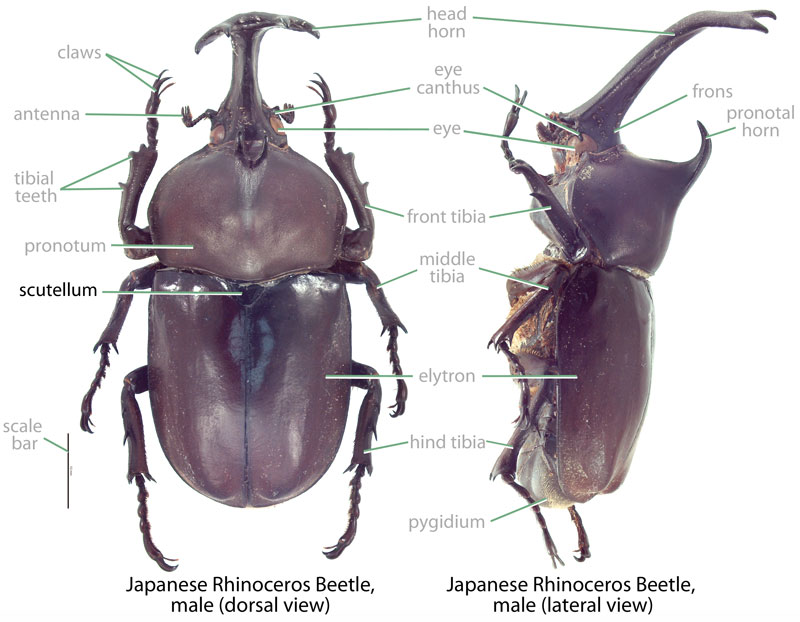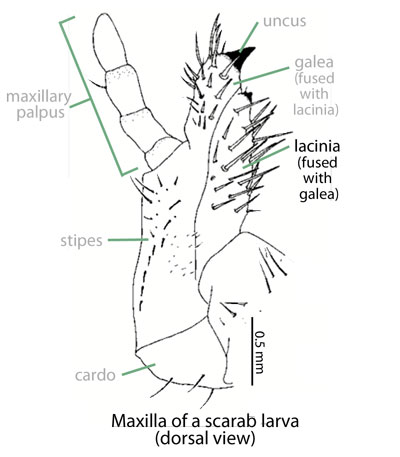Beneficial
none known
Family: Scarabaeidae Subfamily: Scarabaeinae Genus: Onthophagus Species: Onthophagus laminatus MacLeay, 1864
none available
Total body length 11.0–22.0 mm (0.43–0.86 in). Body shape oval; may be caked in dung. Color shiny black. Small to medium-sized Onthophagus, over 6 mm. Clypealclypeal:
of, or referring to, the clypeus
apexapex:
point or edge furthest from the body
weakly produced in major male; apexapex:
point or edge furthest from the body
not produced in minor male or female. Head of major male with two upward curving horns, apexapex:
point or edge furthest from the body
of horns not bifurcatebifurcate:
a process dividing into two points
, distinct transversetransverse:
extending horizontally across a surface
ridge between horns; horns lacking in minor male and female; female and minor male with transversetransverse:
extending horizontally across a surface
(straight) ridge at base of head. Ocular canthuscanthus:
a process extending over and sometimes dividing the eye
completely dividing eye. Pronotumpronotum:
the dorsal surface of the thorax
 with lobe-like process in major male, process reduced in minor male and female. Anterioranterior:
with lobe-like process in major male, process reduced in minor male and female. Anterioranterior:
the front or forward; opposite of posterior
angles of pronotumpronotum:
the dorsal surface of the thorax
 curved outward in both sexes. Front tibiatibia:
curved outward in both sexes. Front tibiatibia:
a segment of the leg articulated with the tarsus and femur
 of male slightly slender and elongate; female tibiatibia:
of male slightly slender and elongate; female tibiatibia:
a segment of the leg articulated with the tarsus and femur
 somewhat more robust. Scutellumscutellum:
somewhat more robust. Scutellumscutellum:
the triangular portion of the thorax between the bases of the elytra
 absent.
absent.
Undescribed. For Onthophagus spp. (Ritcher, 1966Ritcher, 1966:
Ritcher P. 1966. White grubs and their allies: a study of North American scarabaeoid larvae. Oregon State University Monographs, Studies in Entomology 4: 1-219.): Grub C-shaped, hump-backed, cylindrical, and cream-colored. Maxillamaxilla:
set of paired mouthparts located posterior to the mandibles
with galeagalea:
outer branch or lobe of the maxilla
 and lacinialacinia:
and lacinialacinia:
inner portion of the maxilla distinctly separate. Epipharynxepipharynx:
distinctly separate. Epipharynxepipharynx:
lobe on the interior surface of the labrum or clypeus
with tormaetormae:
in scarab larvae, sclerotized structures on the ends of the clypeolateral suture extending towards the mesal line
united mesallymesally:
at or near midline of body
, anterioranterior:
the front or forward; opposite of posterior
phoba present. AntennaeAntennae:
paired sensory organ on head, formed from numerous segments
 4-segmented, distaldistal:
4-segmented, distaldistal:
situated away from the point of articulation, thus usually furthest from the body
segment much reduced. Legs 2-segmented. Prothoracic shieldprothoracic shield:
the chitinous plate behind the head of larvae
 without anteriorly projecting processes. Third abdominal segment bearing a prominent conical, dorsaldorsal:
without anteriorly projecting processes. Third abdominal segment bearing a prominent conical, dorsaldorsal:
of or relating to the upper surface; opposite of ventral
gibbosity covered with numerous short, stout setaesetae:
small, hair-like structure
.
Australia and New Guinea. This species is native to New Guinea and tropical northern Australia. In Australia, it is found from Derby in Western Australia eastward to Gladstone in Queensland (Matthews, 1972Matthews, 1972:
Matthews E. 1972. A revision of the Scarabaeine dung beetles of Australia. I. Tribe Onthophagini. Australian Journal of Zoology Supplementary Series 19: 3-330.).
None. This species feeds on dung as both an adult and larvalarva:
the immature form of an insect; in scarabs, also called grub or white grub; preceded by the egg stage, followed by the pupal stage
 . There are no records of this scarab feeding on live plant tissues.
. There are no records of this scarab feeding on live plant tissues.
This nocturnal species is associated with pastures and open woodland in areas with annual rainfall that exceeds 76 cm (30 in) (Matthews, 1972Matthews, 1972:
Matthews E. 1972. A revision of the Scarabaeine dung beetles of Australia. I. Tribe Onthophagini. Australian Journal of Zoology Supplementary Series 19: 3-330.). Adults are recorded from cattle and horse dung. Life history of the species is poorly known, but related Onthophagus species are dung tunnelers, with females creating a burrow under or near dung (Woodruff, 1973Woodruff, 1973:
Woodruff R. 1973. The scarab beetles of Florida (Coleoptera: Scarabaeidae) part I. The Laparosticti (Subfamilies: Scarabaeinae, Aphodiinae, Hybosorinae, Ochodaeinae, Geotrupinae, Acanthocerinae). Arthropods of Florida and Neighboring Land Areas 8: 1-220.). The burrow is then provisioned with dung in the form of brood balls. Each ball is impregnated with an egg; larval development occurs within the brood ball.
None. This species recycles dung and is beneficial for ranching and farming in Hawaii. Primarily being a dung feeder, this species has never been recorded damaging crop or ornamental plants. Additionally, this species is not a threat to native dung beetles because none occur in Hawaii or Guam.
Recorded, not established. This species was intentionally brought to Hawaii in 1921, though it is appears no specimens were released (Hawaii Division of Forestry, 1923Hawaii Division of Forestry, 1923:
Anonymous. 1923. Report of the entomologist. Hawaii Board of Commissioners of Agriculture and Forestry. Division of Forestry. Honolulu, HI: Hawaiian Gazette Company.).
Not established or recorded. There are no records of this species from Guam.
In Hawaii, this species was intentionally imported.
This dung beetle could easily be confused with similarly colored and small to medium-sized (more than 6 mm) Onthophagus species such as Onthophagus binodis, Onthophagus cuniculus, Onthophagus incensus, Onthophagus armatus, and Onthophagus comperei.
Size can be used to distinguish both sexes of Onthophagus laminatus from O. armatusand O. comperei(O. laminatus is 11.0–22.0 mm [0.43–0.86 in] versus O. armatusand O. comperei that are both under 11.0 mm [0.43 in]).
Major males of these species can be separated by examining the head armature (O. laminatus has two upward curving, non-bifurcate horns connected by a distinct ridge versus O. binodis and O. cuniculusthat lack horns or tubercles, O. incensusand O. comperei that lack a ridge between the horns, O. armatus that has a distinctly bisinuatebisinuate:
possessing two sinuate edges or portions, with two curves
ridge connecting the horns).
Minor males and females can be differentiated by examining the rear of the head (O. laminatus with transversetransverse:
extending horizontally across a surface
(straight) ridge versus O. binodis with slightly curved ridge, O. armatuswith feebly bisinuatebisinuate:
possessing two sinuate edges or portions, with two curves
ridge, O. compereiwith two tubercles), pronotumpronotum:
the dorsal surface of the thorax
 (O. laminatus with lobe-like process versus O. cuniculuswith bi-lobedbi-lobed:
(O. laminatus with lobe-like process versus O. cuniculuswith bi-lobedbi-lobed:
possessed of two lobe-like structures
process, and O. incensus, O. armatusand O. comperei all lacking a distinct process), and the anterioranterior:
the front or forward; opposite of posterior
angles of the pronotumpronotum:
the dorsal surface of the thorax
 (O. laminatus with anterioranterior:
(O. laminatus with anterioranterior:
the front or forward; opposite of posterior
angles curved outward versus O. binodis, O. armatus, O. comperei and O. incensus all with the anterioranterior:
the front or forward; opposite of posterior
angles rounded or quadratequadrate:
square-like in shape
).
Onthophagus cowleyi Blackburn, Onthophagus palmerstoni Blackburn
Report your observation of this beneficial species at our iNaturalist project.